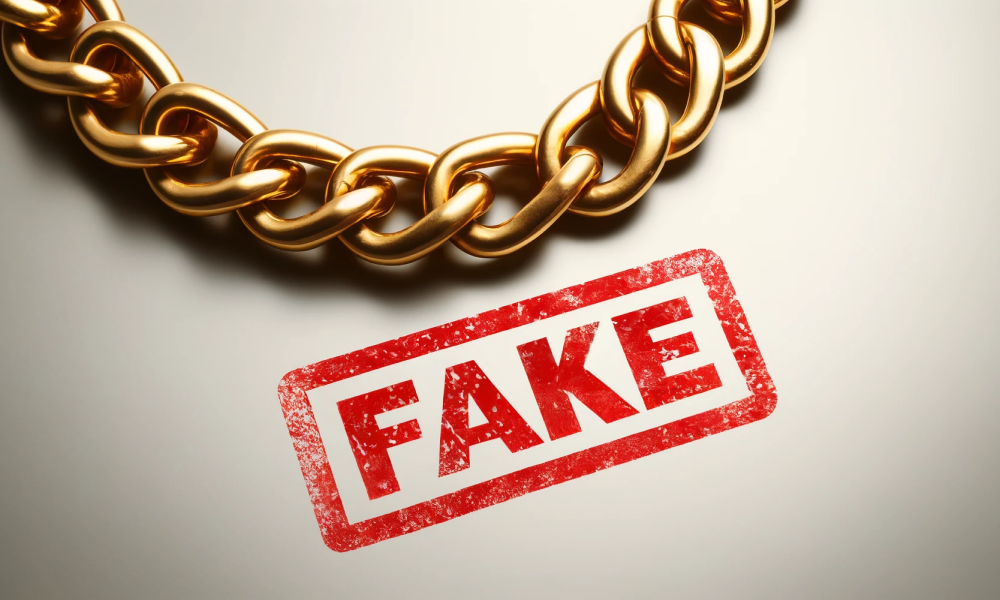This blog post will cover the topic, does gold-plated jewelry tarnish?
Do you love the look of gold-plated jewelry but wonder why it tarnishes? Why does this happen? Does gold vermeil wear off? Does vermeil tarnish and what can be done to alleviate this prevalent and common occurrence involving vermeil? Finding the answers to these questions and learning how to care for your rings, bracelets, necklaces, earrings, or chains helps to keep them in excellent condition.
Vermeil and gold plating can both discolor or turn black over time. This blog post will cover different aspects of gold-plated jewelry tarnishing and what to do about it, answering common questions and concerns regarding your gold-plated items.
How is Gold-plated Jewelry Made?

Gold-plating is made through a process called electroplating. Electroplating features a base metal (commonly silver, brass, and nickel, sometimes copper). A thin layer of real gold is applied over the base metal, resulting in a rich shine mimicking solid gold.
Gold plating is a painstaking process with different steps. These steps are condensed here:
Base Metal: Common base metals for gold plating include copper, brass, silver, or alloys appropriate for gold plating.
The choice of base metal can affect the jewelry's durability and price. Sterling silver with gold plating is typically priced higher than brass. Unlike brass and nickel-type alloys, sterling silver is also mentioned as a base metal because silver is a popular metal.
Base Metal Preparation & Cleaning: Cleaning the base metal removes contaminants, such as bacteria, oils, and debris covering the metal.
Electroplating Bath: The thoroughly cleaned base metal is immersed in an electroplating bath containing a solution of water and chemicals. These chemicals include gold ions in the form of gold chloride or gold cyanide which will be used to plate over the base metal.
Electroplating Process: An electrical current is applied to the bath with the base metal. This causes the gold ions to migrate from the anode to the cathode (the base metal), successfully bonding to the metal surface. The thickness of the gold is controlled through this process.
Gold metal plating is measured with microns. The thicker the plating the more expensive the piece and the longer the plating will last.
Rinsing and Drying: The piece is removed from the electroplating bath and rinsed thoroughly.
Quality Control: The finished gold-plated jewelry is inspected for quality and adherence to design specifications. Any imperfections are fixed.
Interested in learning more? Check out our blog, "What is 18K Gold Plated Jewelry?" For more information.
Why Does The Plating Get Tarnished
Chemical Reactions: Tarnishing of gold-plated jewelry occurs when the thin layer of gold on the surface reacts to something or some substance it comes into contact with. Common culprits occur during everyday life and are not as far-off as you would imagine! Pollution, certain foods, cosmetics, lotions, perfumes/fragrances/cologne/body spray, SPF, glitter, and other substances coat the surface, leaving residue behind. Some of these may cause the gold plating to oxidize, corrode, discolor, and tarnish.
Gold Plating Quality: The quality of the gold-plating jewelry plays an important role in the overall wearability of the piece. Thick layers of gold plating will be more resistant to damage or discoloration than thin layers of gold.
Things that Tarnish Your Gold-Plated Jewelry

Did you know some of your favorite products may actually increase gold-plated tarnishing? Here are some for consideration:
Sulfur Compounds: Sulfur-containing compounds found in the environment and other frequently used common household products, food, and liquids may increase the fading of the gold-plating, resulting in tarnishing and discoloration. Alcohol and chlorine are common sulfur-containing products.
Cosmetics and Lotions: Sometimes, the finishing touch and your favorite body care may increase the tarnishing and discoloration of gold-plating. Finish your look LAST by placing on your jewelry AFTER lotions, cosmetics, and body sprays will protect the top coat from being covered in the chemicals from these body care products.
Household Cleaning Products: Harsh chemicals found in household cleaners, like bleach or ammonia, can accelerate tarnishing if they come into contact with your jewelry. Removing your jewelry and storing it away in a safe place before cleaning or using these products will protect them from potentially irreversible damage.
Wear and Tear: Jewelry is made to be worn and shown off, showcasing your personality and style. However, wearing your gold-plated jewelry frequently exposes them to the harsh elements mentioned above. Plus, your natural skin oils cause the gold plating to gradually wear off over time, resulting in tarnishing and discoloration.
Swimming Pools/Hot Tubs/Spas/Jacuzzi: Chlorinated water in swimming pools, hot tubs, spas, and jacuzzis react when they come into contact with gold-plated jewelry, causing the top coat to discolor and tarnish.
Time and Natural Oxidation: Even with proper care, gold-plated jewelry may naturally tarnish due to exposure to oxygen and environmental factors over longer time periods--gold-plated jewelry doesn't last forever.
Worried if you should wear your gold in the shower? Check out our blog, Can You Wear Gold in the Shower? for more information.
Things that Determine How Long the Plating Would Last
Here is a short list of things to consider when you are wondering how long the gold plating with last without fading and tarnishing:
Thicker Plating: The thickness of the gold plating layer is a critical factor in the overall quality of the piece and how long the gold plating will last. Thicker layers of gold plating last longer than thin layers because they offer more protection against wear and tarnishing due to their thickness. Thin layers wear away easier--think of it like nail polish, chipping and fading.
Frequency of Use: Do you love wearing your gold-plated jewelry frequently? Gold-plated jewelry you love to wear the most is subject to excessive wear and tear, leading to the gradual thinning of the gold plating and exposing the base metal. Occasional or special occasion wear may make the plating last longer because the gold-plated piece isn't exposed to air, damage, and chemicals.
Base Metal: Some base metals, like copper or nickel, are more prone to corrosion than others. The base metal underneath the gold plating impacts how quickly the jewelry tarnishes. The base metal may "agree" with the gold-plating, like silver, extending the life of the piece without being so prone to fading away and tarnishing.
Proper Maintenance and Care: Abrasive materials can strip away the gold plating or damage it, making the jewelry more prone to tarnishing and discoloration. It is not necessary to scrub your gold-plated jewelry with harsh chemicals and stiff bristle brushes. Instead, gently pat your gold-plated jewelry with a mild soapy solution, and using a soft bristle brush will help remove bacteria, debris, and oils.
Storage and Preservation: Storing your jewelry in a jewelry box, jewelry bag, or airtight bag/container prevents exposure to moisture. Separating your jewelry into individual bags and boxes prevents scratching from the stones and other design elements.
👉 Learn more about all gold karats by reading this article: "Introduction to All Gold Karats: 9k, 10k, 14k, 18k, 22k, and 24k"
Questions fréquemment posées
Below are two FAQs regarding gold-plated jewelry.
How long does it take for gold-plated jewelry to tarnish?
The time it takes for gold-plated jewelry to tarnish varies. The life of the gold plating includes several factors, including the thickness of the gold plating, how often the jewelry is worn and taken from its storage box/bag, the care and maintenance it receives, the base metal, and the overall quality and craftsmanship of the gold plating. Some gold plating can last years or months–some brands and designers may offer guarantees or warranties on the life of their gold-plated jewelry.
What gold-plated jewelry does not tarnish?
Most gold-plated jewelry will tarnish over time, as the gold layer on the surface can react with various environmental factors, chemicals, and wear and tear, fading and exposing the base metal. Whether you have rings, bracelets, necklaces, or chains, all gold-plated jewelry has a shelf life.
Higher-quality gold-plated jewelry with thicker plating resists tarnishing for a longer time. Proper maintenance and care, which includes avoiding exposure to harsh chemicals, air/moisture, and abrasive materials (chlorine and cleaning products), will extend the life of your gold-plated jewelry.
Conclusion
Does gold-plated jewelry tarnish? Extend the life of your favorite gold-plated jewelry by taking good care of it. Recognizing tarnishing is an attribute of gold-plated jewelry but it can be diminished and reversed by following a few simple pointers outlined in this article.
Interested in learning more about your jewelry and some of its components, called findings? Check out our blog, All Tennis Bracelet Clasp Types Explained.




















































































